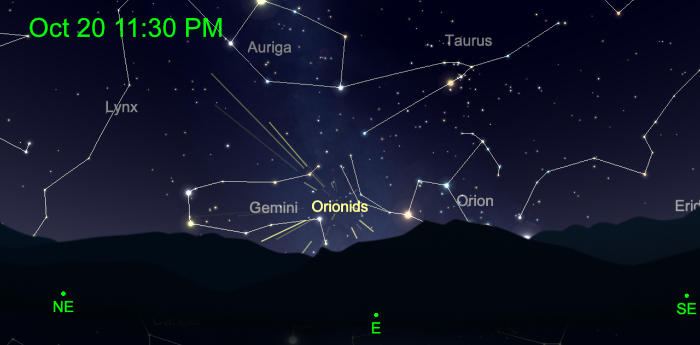| 2020 Oct: The Orionids are Coming (2020-9-29) ⬅︎ |
 |
The Orionids is a meteor shower associated with the most famous comet of all, Comet Halley. Because the
debris left behind by this comet is traveling so rapidly, when the bits of dust and rock hit earth, they often appear
as glowing 'fireballs' that streak across the sky. If you love natural fireworks, this meteor shower is not to be
missed!
This leads to the question, what is a comet and how does it cause a meteor shower?
To our ancestors comets were to be feared because they
appeared unpredictably and looked like large glowing
balls with long tails -- objects very different from the fixed stars and predictable planets. Comets were often
considered omens that bad things were about to happen.
That began to change in the year 1705 when the famous scientist, Edmund Halley, calculated that a comet would
appear
in the year 1759. He had been studying comet sightings from the past and realized that at least one was a regular
visitor. Although Halley died in 1742, the comet appeared on schedule and people came to understand that comets
could be
explained by science and need not be feared. It was later named in his honor.
A comet is a small -- about the size of Mt Rainier -- distant world made mostly of ice, dirt and rock that
orbits the sun in an highly elliptical orbit.
When it approaches the sun, the sun's heat and solar wind cause some of its material to loosen
and get blown into space forming a debris field.
From October 2 through November 7, Earth will be traveling through this debris field. It
will enter the thickest part of it on the night of Oct 20.
The Orionids are considered to be one of the most beautiful meteor showers of the year because of their high
speeds -- as
fast as 148,000 mph -- which produce glowing fireballs that can last for several seconds in our sky. But, to see the
best fireballs, you'll likely need to stay up as late as possible. Why? The
diagram below will help you understand...
Earth orbits the sun at 67,000 mph. At sunset, we are turned away from earth's direction of orbit which means the
meteors have to 'catch up' to us to hit our sky. At midnight, we are sideways so the meteors side-swipe us. By
sunrise, we are turned into the
direction of orbit and the debris and earth slam
head-on into each other. So, the later you stay up, the higher the speeds of the meteors and the better
the show.
The radiant, the point from which the meteors appear to come, lies in the constellation Orion close to the star
Betelgeuse. But they can be seen over a large area of the sky. You should expect about 15 per hour -- one every
four minutes -- but sometimes there are much more.
It will be dark enough to start viewing the Orionids around 9pm but the radiant won't rise above the horizon until
around 12:10am. As the radiant rises higher, the chances of seeing meteors rise as well. Good viewing
will continue until around 5am, at the start of dawn.
Good news: for 2020, the moon will be crescent and set around 9:15pm allowing great viewing of even the
dimmest meteors without interference from moonlight.
Be sure to check out our Star Guide feature with its tools for knowing what's out each night and where to
look. Good luck! |
| |



